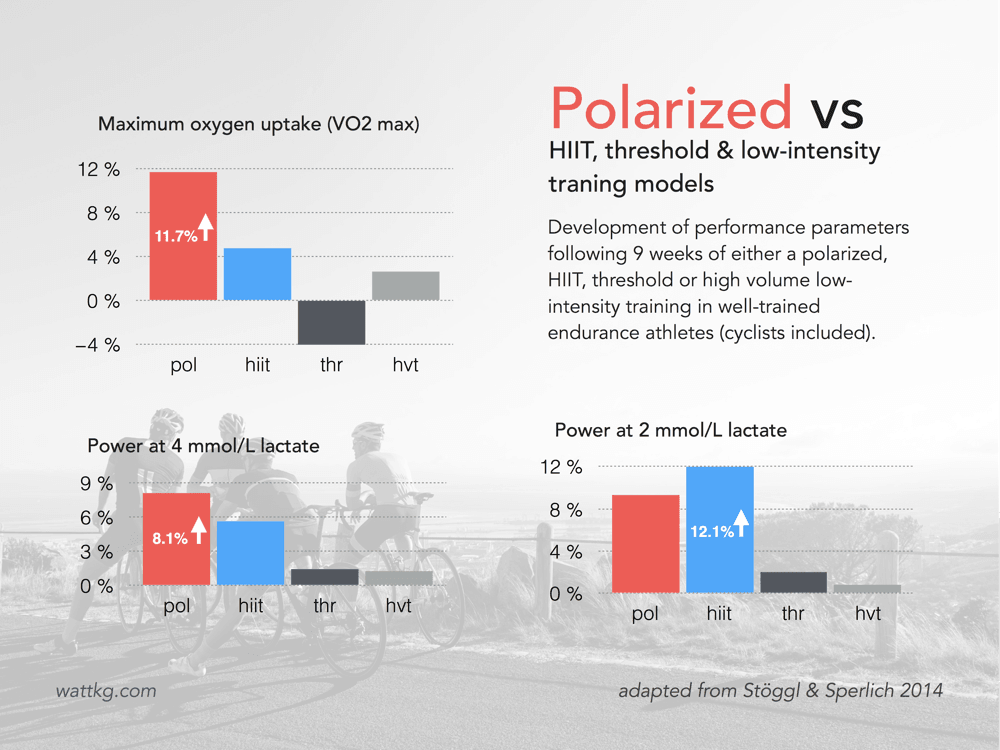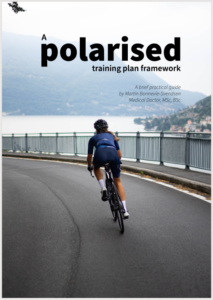Imagine the following…
Base training is done, and race season is drawing inevitably closer. You already know which wheel you will need to cling onto to get the results you want. But, you could use some extra watts per kilo to make it happen.
How would you organize the next 9 weeks to achieve the biggest possible lift in threshold power and VO2 max?
In the above situation, this 2014 study on polarised training could come in handy (1).
Featured image credit: Ian Sherrifs/Shutterstock.com
Polarised training has greater impact on key endurance variables than threshold, high intensity, or high volume training
This study compared the effect of four different training models on well-trained and competitive endurance athletes (1).
Who were the athletes?
48 athletes from cycling (n=15), triathlon (n=9), running (n=16) and cross-country skiing (n=8) partook in the experiment. The mean age of participants was 31 years and VO2 max ranged from 52 to 75 ml/kg/min, with a mean value of 62.6 ml/kg/min. They were all used to training more than 5 sessions a week (10-20 hours) and had been involved in competitive racing for 8-20 years.
How did they train?
Athletes were divided in four groups. Each group undertook a 9 week training program that placed a particular focus on either:
- High volumes of low-intensity training
- Threshold training
- High-intensity training
- Polarised training
The high volume group (HVT), threshold group (THR) and polarised group (POL) all had their program organized in three blocks of 3 weeks. Each block was structured as 2 weeks with higher volumes & focus on the emphasized training method, followed by 1 recovery week.
For the THR group, this meant 3 weekly sessions of intervals at lactate threshold in the 2 harder weeks. In a similar fashion, the POL group undertook two weekly high-intensity intervals (4×4 min at 90-95% of max heart rate) in the two harder weeks.
The high-intensity group (HIIT) performed two blocks of 16 days, each of which contained 12 high-intensity intervals. Each block was preceded by an adaptation week with 2 interval and 4 low-intensity sessions.
How did they perform?
Before and after the 9 week training period, all riders were tested for a variety of performance parameters, including:
- VO2 max
- Power at 2 mmol/L lactate
- Power at 4 mmol/L lactate
- Peak power
The figure below illustrate the results.

The polarized group achieved greater performance development across all tests but power at 2 mmol/L lactate.
VO2 max increased by 11.7% in the polarized group. By comparison, the development was 4.8%, minus 4.1% and 2.6% in the HIIT, threshold and high-volume groups, respectively.
Power at 4 mmol/L lactate (approximate threshold power) improved by 8.1% in the polarised group. This in contrast to the 5.6%, 1.4% and 1.2% development in the HIIT, threshold and high-volume groups.
Power at 2 mmo/L lactate (below threshold power) increased the most in the HIIT group, by 12.1%. The improvement in the polarised, threshold and high-volume groups was 9.3%, 2.0% and 0.8% respectively.
The between-group difference reached statistical significance for; absolute VO2 max increase in POL vs all other groups (p<0.01-0.05); threshold power improvement in POL vs THR and HVT group (p<0.05).
Pretty exciting numbers, no?
Polarised training for the win – most often?
Overall, these results clearly favor the polarised training model. It performed best across all performance parameters, with the exception of power at low intensity. And, even here the difference between POL and HIIT was quite marginal (3 percentage points).
Furthermore, it is exciting to see double digit development is such well-trained athletes (10-20 weekly training hours). It is interesting to see that such high performance gains were achieved without increasing the weekly training hours substantially.
Even more interesting is the fact that these riders used the traditional 4×4 min high-intensity interval. This might very well NOT be the most effective interval training format for well-trained cyclists, as demonstrated when contrasted to the 30/15 short interval and the 4×8 min high-intensive interval (2-3).
The argument for polarised training gets even stronger when we consider additional papers in the training literature (4).
…experimental studies lasting 6 weeks to 5 months demonstrate superior responses to polarized training intensity distribution, especially when compared with training intensity distribution that emphasizes threshold of high volume low-intensity training.
– Stöggl & Sperlich, Frontiers in Physiology
The authors highlight that it may be too soon to crown the “optimal” distribution of training intensity. But if you were to put your money on one model, polarised training appears a strong alternative.
Get the 9 week polarised plan framework in my free newsletter

When you subscribe to my newsletter you will receive the sprint-in-LIT and other workout instructions, science reviews and discussions of best training practices. There is also occasional information about my paid services. I will take care not to clutter your inbox.
Good luck with your polarised training!
Why you should NOT close the book on HIIT and threshold training
There is an inherent challenge with applying results from research papers to your own training.
Research papers often won’t be able to accurately reproduce all variations of real-life training.
For instance, one aspect of the above study was to contrast polarised training to threshold training. To do so, training plans used a strictly polarised and threshold training program. However, threshold training is often used alongside high-intensive and low-intensity training (a model called “pyramidal training”) (4).
As such, the 9 week threshold plan in this study is not necessarily representative to how threshold training is being used in real-world training.
Furthermore, there is always the chance that riders at different fitness levels might respond differently to different training methods. It could be that more elite riders would respond differently to threshold training compared to the subjects in this experiment.
As such, it would be overly premature to write off threshold training completely.
Similarly, the training model with blocks of frequent high-intensity training too has been shown to yield very exciting results for certain types of athletes.
So don’t go tossing the baby out with the bathwater just yet.
Take-home message
The main take away from this article is that the polarised training model is a well documented strategy for improving physical capacity in cyclists ranging from beginners to well-trained.
When compared to strict threshold or high-intensity training, the polarised model appears to be superior for this rider segment.
If you are an amateur cyclist below elite-level in your age group, you will have great chances of improving your results with a combination of regular high-intensity intervals and continuous low-intensity rides.
References:
- Stöggl T and Sperlich B. Polarized training has greater impact on key endurance variables that threshold, high intensity, or high volume training. Frontiers in Physiology, 2014;5:33
- Rønnestad BR et al. Short intervals induce superior training adaptations compared with long intervals in cyclists – An effort-matched approach. Scandinavian Journal of Medicine & Science in Sports, 2015;25:143-151
- Seiler S et al. Adaptations to aerobic interval training: interactive effects of exercise intensity and total work duration. Scandinavian Journal of Medicine & Science in Sports, 2013;23:74-83
- Stöggl T and Sperlich B. The training intensity distribution among well-trained and elite endurance athletes. Frontiers in Physiology, 2015;6:295
